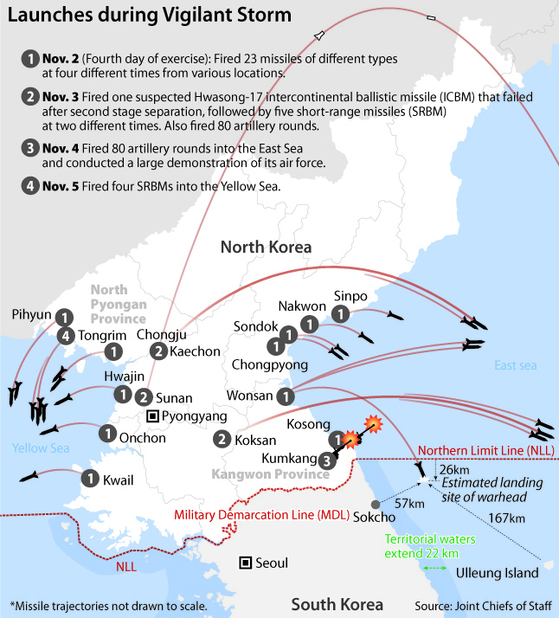Vigilant Storm ends with more North Korean missile launches
![Two U.S. B-1B supersonic stealth bombers (upper right) are flanked by four U.S. F-16 fighters and four South Korea F-35A stealth fighters during the Vigilant Storm exercise on Saturday. [JOINT CHIEFS OF STAFF]](https://koreajoongangdaily.joins.com/data/photo/2022/11/06/293fda48-b46a-4034-a154-a795a826ffd6.jpg)
Two U.S. B-1B supersonic stealth bombers (upper right) are flanked by four U.S. F-16 fighters and four South Korea F-35A stealth fighters during the Vigilant Storm exercise on Saturday. [JOINT CHIEFS OF STAFF]
North Korea maintained its barrage of missile launches with four more on Saturday morning as the United States flew two B-1B supersonic strategic bombers over the Korean Peninsula on the last day of a high-profile joint exercise with South Korea.
Seoul's Joint Chiefs of Staff said that it detected four short-range ballistic missiles being fired from 11:32 to 11:59 a.m. Saturday. The missiles all flew approximately 130 kilometers (81 miles), peaking at 20 kilometers and reaching a top speed of Mach 5.
Unusually, the launch site was not located in an area of the country's western or eastern coasts close to the North's traditional foes South Korea or Japan, but in Tongrim, North Pyongan Province, only 20 kilometers from the Chinese border city of Dandong.
The launches took place on the last day of a much-publicized joint South Korea-U.S. Air Force exercise dubbed Vigilant Storm that was originally scheduled to end on Friday but was extended by one day in response to the North's missile launches last week, which included a failed intercontinental ballistic missile (ICBM) launch.

For the last day of the exercise, the United States mobilized two B-1B Lancer bombers that took off from Guam and flew over South Korea alongside four South Korean F-35A fighter jets and four American F-16 jets, according to the South Korean military.
Over 240 aircraft — including F-35A stealth fighters, F-15K jets and KF-16 jets from the South Korean Air Force, as well as F-35B stealth fighters, EA-18 electronic warfare aircraft, KC-135 tankers and U-2 high-altitude reconnaissance aircraft from the U.S. military — conducted a total 1,600 sorties during the six-day exercise.
The last time the United States flew B-1B bombers over South Korea was in 2017, when the North Korea conducted its sixth nuclear test and conducted its first ICBM tests.
South Korea's Joint Chiefs of Staff said the presence of the B-1B bombers in the joint exercise showed the allies' ability to "sternly respond" to North Korean provocations and America's "ironclad" commitment to South Korea's defense.
North Korea is sensitive to such projections of U.S. military might close to its territory.
The regime has played up the threat from the B-1B bomber by describing it as a "nuclear strategic bomber" in state media reports, even though the plane has only been equipped with conventional weapons since the mid-1990s.
The B-1B bombers' deployment for the exercise came after defense chiefs from South Korea and the United States announced last Thursday that U.S. strategic assets will be continuously deployed to the Korean Peninsula while warning North Korean leader Kim Jong-un his regime would "end" if he used nuclear weapons against Seoul or Tokyo.
Speaking at a joint press conference at the Pentagon after the 54th security consultative meeting (SCM) between the allies, South Korean Defense Minister Lee Jong-sup said he and U.S. Secretary of Defense Lloyd Austin promised to employ U.S. strategic assets to a level "equivalent to constant deployment" by "increasing the frequency and intensity of strategic asset deployment in and around the Korean Peninsula."
Austin said that although the shift would not result in the permanent relocation of more U.S. troops or assets, such as an aircraft carrier, to the region, it would entail a greater and more formidable U.S. military presence on rotation to the peninsula and the surrounding waters.
The U.S. defense secretary also warned in a joint communique issued after the SCM that "any nuclear attack against the United States or its allies and partners, including the use of non-strategic nuclear weapons, is unacceptable and will result in the end of the Kim regime."
In the joint communique, the allies said they would heighten information-sharing, consultations and "joint planning and execution" to deter North Korea's use of nuclear weapons.
While the communique did not go into detail on what "joint planning and execution" would entail, the phrase did suggest a more active role for Seoul in how U.S. deterrence capabilities might be put to use.
Calls have been growing in South Korea for Seoul to seek a nuclear-sharing arrangement like that of the North Atlantic Treaty Organization (NATO) or other measures to make up for the lack of its own independent nuclear deterrent.
BY MICHAEL LEE [lee.junhyuk@joongang.co.kr]










with the Korea JoongAng Daily
To write comments, please log in to one of the accounts.
Standards Board Policy (0/250자)